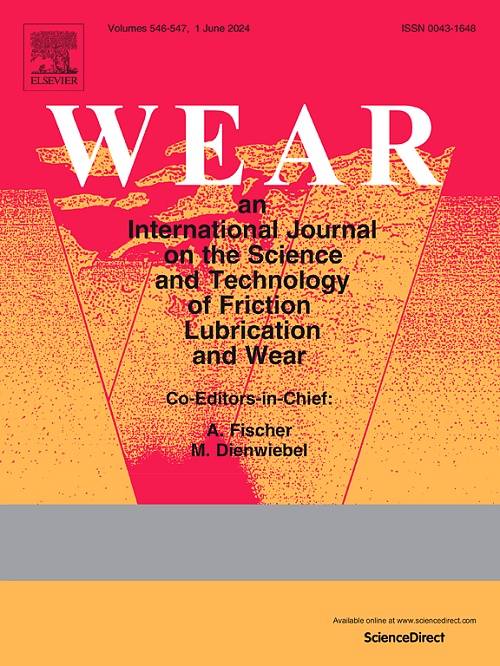Regulation mechanism of transfer film on fretting regime via self-mated and hetero-mated diamond-like carbon films
IF 6.1
1区 工程技术
Q1 ENGINEERING, MECHANICAL
引用次数: 0
Abstract
Self-lubricating solid films have been demonstrated to be effective in substantially reducing fretting wear. However, different films exhibit diverse fretting behaviors under different fretting running states. Therefore, it is of utmost importance to explore the friction-reduction mechanisms of self-lubricating films in different fretting regimes. The fretting behaviors of two solid lubricating systems, namely the Diamond-like carbon (DLC)/DLC self-mated pair and the molybdenum disulfide (MoS2)/DLC hetero-mated pair, were evaluated. A detailed investigation was conducted on their fretting wear performances in different fretting regimes. Based on the research on transfer films, the fretting wear mechanisms were summarized. The research findings reveal that the DLC/DLC friction pair can efficiently transfer the DLC film on the substrate surface to the counterpart ball surface with low wear and dissipated energy, forming a transfer film with a higher degree of graphitization. In contrast, when amorphous carbon and MoS2 are completely intermixed, the DLC/MoS2 friction pair forms a transfer film with the co-presence of the layered structure of MoS2 and amorphous carbon with a high sp2 content. Their different formation mechanisms and structures are the key determinants for the discrepancies in the fretting behaviors of the two friction pairs within distinct fretting regimes. Consequently, by implementing diverse friction pairs to introduce distinct solid lubricating films, precise manipulation of the friction interface and the structure of transfer film can be achieved. This approach is designed to optimize the fretting performance, ensuring enhanced friction reduction and anti-wear capabilities across various fretting regimes.

自配和异配类金刚石碳膜转移膜对微动状态的调节机理
自润滑固体膜已被证明是有效的,大大减少微动磨损。不同薄膜在不同的微动运行状态下表现出不同的微动行为。因此,研究不同微动状态下自润滑膜的减摩机理是十分重要的。研究了类金刚石(DLC)/DLC自配对和二硫化钼(MoS2)/DLC异配对两种固体润滑体系的微动行为。对其在不同微动状态下的微动磨损性能进行了详细的研究。在对转移膜进行研究的基础上,总结了微动磨损机理。研究结果表明,DLC/DLC摩擦副可以有效地将衬底表面的DLC膜转移到对应的球表面,具有低磨损和低能量耗散,形成石墨化程度较高的转移膜。相反,当非晶碳和MoS2完全混合时,DLC/MoS2摩擦对形成了MoS2和非晶碳层状结构共存的转移膜,且sp2含量高。它们不同的形成机制和结构是两摩擦副在不同微动状态下微动行为差异的关键决定因素。因此,通过实施不同的摩擦副来引入不同的固体润滑膜,可以实现对摩擦界面和转移膜结构的精确操纵。这种方法旨在优化微动性能,确保在各种微动制度下增强摩擦减少和抗磨损能力。
本文章由计算机程序翻译,如有差异,请以英文原文为准。
求助全文
约1分钟内获得全文
求助全文
来源期刊

Wear
工程技术-材料科学:综合
CiteScore
8.80
自引率
8.00%
发文量
280
审稿时长
47 days
期刊介绍:
Wear journal is dedicated to the advancement of basic and applied knowledge concerning the nature of wear of materials. Broadly, topics of interest range from development of fundamental understanding of the mechanisms of wear to innovative solutions to practical engineering problems. Authors of experimental studies are expected to comment on the repeatability of the data, and whenever possible, conduct multiple measurements under similar testing conditions. Further, Wear embraces the highest standards of professional ethics, and the detection of matching content, either in written or graphical form, from other publications by the current authors or by others, may result in rejection.
 求助内容:
求助内容: 应助结果提醒方式:
应助结果提醒方式:


